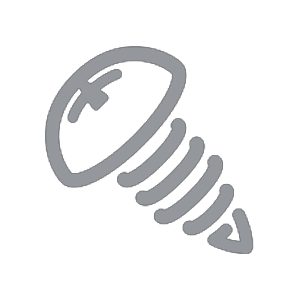Protective treatments
burnishing
Protective treatments
Burnishing
Decorative treatments: burnishing
What is burnishing?
This is a process that takes place by immersion in an aqueous bath of alkaline salts dissolved in water at a concentration that raises the boiling temperature to around 140°C. The parts to be burnished must be well degreased so that they are perfectly wettable, if necessary mild pickling can be carried out in order to remove oxides and scale, after the necessary rinses the parts are immersed, in barrels or baskets, in the burnishing bath.
The process takes about half an hour. After that, rinsing and drying operations follow.
Burnishing does not impart special strength qualities to the treated ferrous material, so effective corrosion resistance performance should not be expected. To impart better aesthetics, shine and a minimum of corrosion resistance, especially to small parts, a light oil film can be applied. Burnishing is done chemically, without the need for electric current for the reaction, however, parts larger than the small parts are treated separately by hanging or resting them in appropriate baskets.
How does the process take place?
The oxide that is formed is not due to material input but to a transformation of the original surface of the object. The aluminum surface undergoing anodizing is progressively oxidized from the outside of the surface progressing inward. The ‘oxide that is formed has a larger volume than the original metal (aluminum) so that apparently, from a dimensional point of view, it seems away is a material contribution, in reality the thickness of oxide partly “penetrates” into the metal partly “grows” outward. In practice for a thickness of e.g. 10 microns, 5 microns penetrated and 5 microns expanded so the geometric increase amounts to 5 microns. Note that, on a diameter, the 10-micron thickness produces an increase in diameter of 10 microns, not 20.
Oxide also tends to form fairly uniformly in recesses, undercuts, and inside pipes. The structure of the oxide is very similar to the “honeycomb” structure with vertical tubules with respect to the thickness formed. These tubules are much less than a micron in diameter, but particular dyes can penetrate them, being able to impart a wide variety of colorations to the oxide layer. Following the formation of the oxide layer and, eventual staining, a pore-closing operation is performed in order to ensure compactness and corrosion resistance. This operation is called fixing and can be done cold or hot. in any case the pores are closed, however, it turns out to be safer to heat fix especially for colored oxide layers.
Decorative treatments: burnishing
What is burnishing?
This is a process that takes place by immersion in an aqueous bath of alkaline salts dissolved in water at a concentration that raises the boiling temperature to around 140°C. The parts to be burnished must be well degreased so that they are perfectly wettable, if necessary mild pickling can be carried out in order to remove oxides and scale, after the necessary rinses the parts are immersed, in barrels or baskets, in the burnishing bath.
The process takes about half an hour. After that, rinsing and drying operations follow.
Burnishing does not impart special strength qualities to the treated ferrous material, so effective corrosion resistance performance should not be expected. To impart better aesthetics, shine and a minimum of corrosion resistance, especially to small parts, a light oil film can be applied. Burnishing is done chemically, without the need for electric current for the reaction, however, parts larger than the small parts are treated separately by hanging or resting them in appropriate baskets.
How does the process take place?
The oxide that is formed is not due to material input but to a transformation of the original surface of the object. The aluminum surface undergoing anodizing is progressively oxidized from the outside of the surface progressing inward. The ‘oxide that is formed has a larger volume than the original metal (aluminum) so that apparently, from a dimensional point of view, it seems away is a material contribution, in reality the thickness of oxide partly “penetrates” into the metal partly “grows” outward. In practice for a thickness of e.g. 10 microns, 5 microns penetrated and 5 microns expanded so the geometric increase amounts to 5 microns. Note that, on a diameter, the 10-micron thickness produces an increase in diameter of 10 microns, not 20.
Oxide also tends to form fairly uniformly in recesses, undercuts, and inside pipes. The structure of the oxide is very similar to the “honeycomb” structure with vertical tubules with respect to the thickness formed. These tubules are much less than a micron in diameter, but particular dyes can penetrate them, being able to impart a wide variety of colorations to the oxide layer. Following the formation of the oxide layer and, eventual staining, a pore-closing operation is performed in order to ensure compactness and corrosion resistance. This operation is called fixing and can be done cold or hot. in any case the pores are closed, however, it turns out to be safer to heat fix especially for colored oxide layers.
Treatable materials
- Medium-low carbon ferrous materials
- Carbon steel
- Iron, C40, C45, AVP, AVZ
- Tempered steels, 8.8, 10.9, 12.9
Regulations
- Small parts can be conveniently processed in rotobarrel.
- Any customer specifications..
Possible finishes
- White (neutral)
- Black
- Blue
- Red
Maximum treatable size
840 x 320 x 370 mm
Treatable materials
- Medium-low carbon ferrous materials
- Carbon steel
- Iron, C40, C45, AVP, AVZ
- Tempered steels, 8.8, 10.9, 12.9
Possible finishes
- White (neutral)
- Black
- Blue
- Red
Regulations
- Small parts can be conveniently processed in rotobarrel.
- Any customer specifications.
Maximum treatable size
840 x 320 x 370 mm
Sectors
implementing
implementing
Application areas

Mechanic

Tooling

Weapons

Ferrous fasteners / hardware

Gears

Mold parts

Springs

